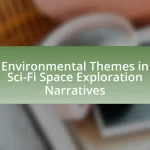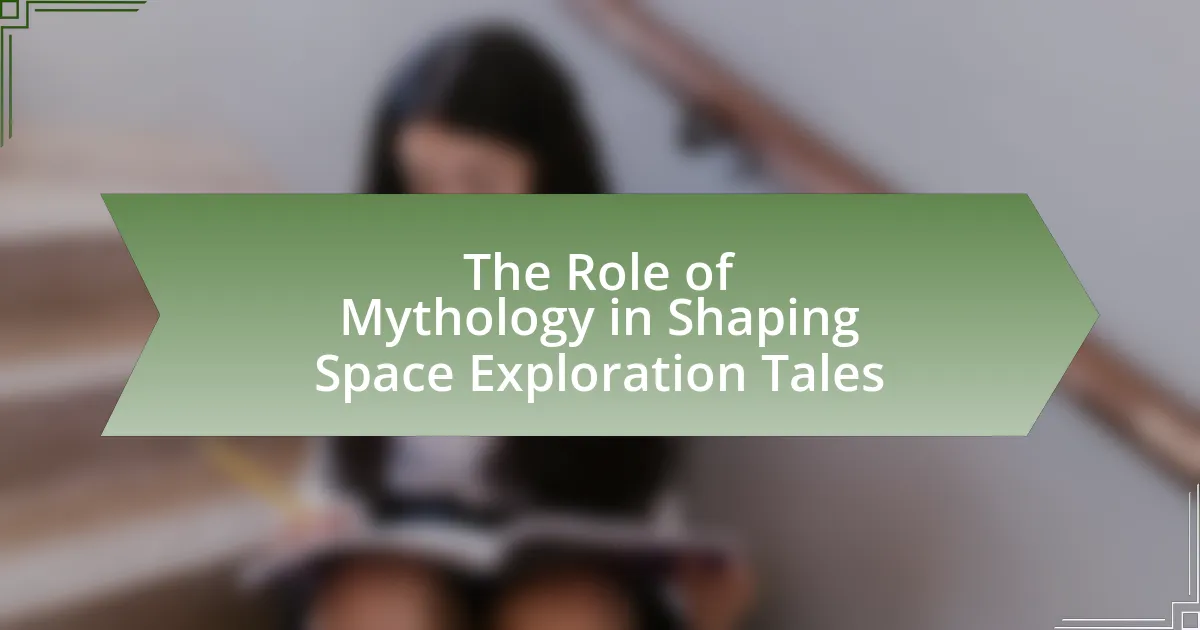Alien cultures in sci-fi literature encompass a range of imaginative societies created by authors to explore themes of identity, morality, and the human condition through extraterrestrial perspectives. The article examines how authors depict these cultures through distinct social structures, languages, and belief systems, employing narrative techniques such as world-building and cultural juxtaposition. It highlights the significance of alien cultures in reflecting human societal issues, the impact of cultural differences on character interactions, and the role of alien languages in enhancing world-building. Additionally, the article categorizes various types of alien cultures, including utopian and dystopian societies, and discusses how these cultures influence plot development and character growth in science fiction narratives.
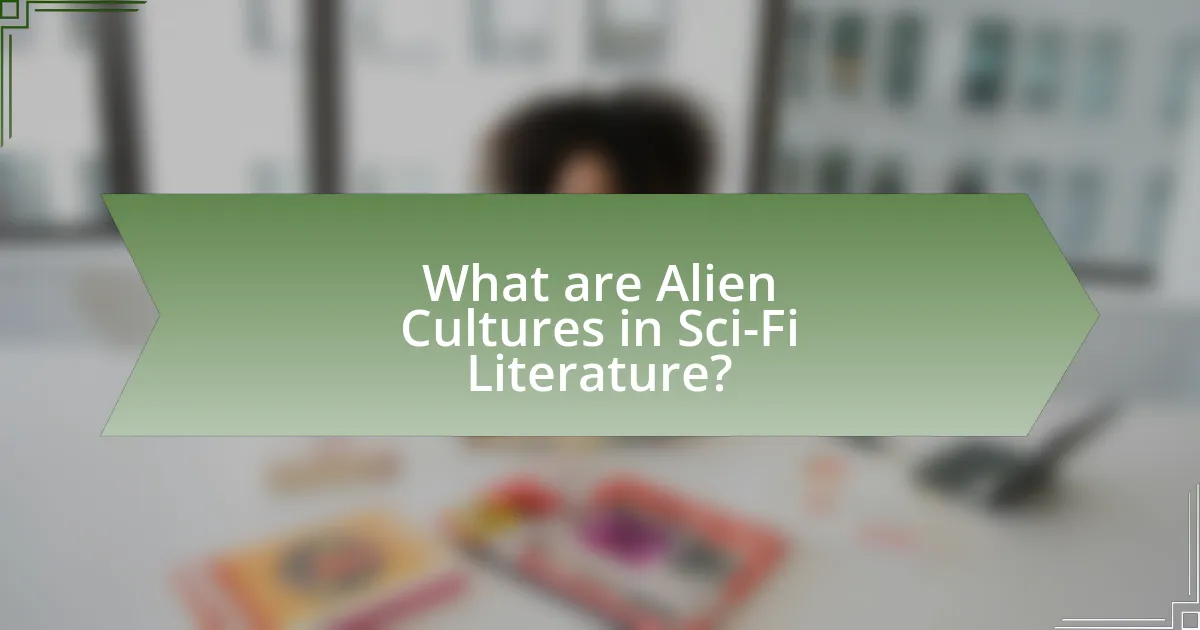
What are Alien Cultures in Sci-Fi Literature?
Alien cultures in sci-fi literature refer to the diverse and imaginative societies created by authors to explore themes of identity, morality, and the human condition through the lens of extraterrestrial beings. These cultures often possess unique languages, social structures, belief systems, and technologies that reflect their distinct evolutionary paths and environments. For example, in Frank Herbert’s “Dune,” the Fremen culture showcases a complex relationship with their desert planet, emphasizing survival and spirituality, while in Arthur C. Clarke’s “Childhood’s End,” the Overlords represent a highly advanced civilization that challenges human notions of progress and freedom. Such representations serve to provoke thought about humanity’s place in the universe and the potential for coexistence with vastly different life forms.
How do authors depict alien cultures in their works?
Authors depict alien cultures in their works by creating distinct social structures, languages, and belief systems that reflect the diversity of human experience. For instance, in “Dune” by Frank Herbert, the Fremen culture is characterized by its unique customs, survival strategies in a harsh desert environment, and a deep connection to their planet, which illustrates how environment shapes culture. Similarly, in “The Left Hand of Darkness” by Ursula K. Le Guin, the portrayal of the Gethenians, who are ambisexual, challenges traditional gender norms and explores themes of identity and social interaction. These depictions often serve to critique or mirror human societies, providing insights into our own cultural practices and assumptions.
What narrative techniques are used to illustrate alien societies?
Narrative techniques used to illustrate alien societies include world-building, perspective shifts, and cultural juxtaposition. World-building involves creating detailed settings that reflect the unique characteristics of alien civilizations, often through descriptive language and intricate social structures. Perspective shifts allow readers to experience the alien culture through the eyes of its inhabitants, fostering empathy and understanding. Cultural juxtaposition contrasts alien societies with human norms, highlighting differences and similarities that provoke thought about humanity itself. These techniques are evident in works like Ursula K. Le Guin’s “The Dispossessed,” where the contrasting societies of Anarres and Urras illustrate diverse political ideologies and social structures.
How do cultural differences shape character interactions?
Cultural differences significantly shape character interactions by influencing communication styles, values, and social norms. For instance, in sci-fi literature, characters from collectivist cultures may prioritize group harmony and indirect communication, while those from individualistic cultures might emphasize personal expression and directness. This divergence can lead to misunderstandings or conflicts, as seen in works like “The Left Hand of Darkness” by Ursula K. Le Guin, where the protagonist navigates the complexities of a society with radically different gender norms and social structures. Such interactions highlight how cultural contexts dictate behavior and expectations, ultimately affecting relationships and plot development.
Why is the exploration of alien cultures significant in sci-fi?
The exploration of alien cultures is significant in sci-fi because it allows for the examination of human nature and societal structures through the lens of the unfamiliar. By presenting diverse alien civilizations, science fiction challenges readers to reflect on their own cultural norms, ethics, and values. For instance, works like Arthur C. Clarke’s “Childhood’s End” illustrate how contact with an advanced alien race prompts humanity to confront its limitations and potential for growth. This exploration fosters empathy and understanding, encouraging readers to consider perspectives beyond their own experiences.
What themes emerge from the portrayal of alien societies?
The portrayal of alien societies often reveals themes of diversity, conflict, and the exploration of identity. These themes highlight the vast differences in cultural practices, social structures, and moral values among alien species, emphasizing the complexity of coexistence. For instance, in Arthur C. Clarke’s “Childhood’s End,” the theme of conflict arises from the interaction between humanity and the Overlords, showcasing how differing ideologies can lead to tension. Additionally, the exploration of identity is evident in works like “The Left Hand of Darkness” by Ursula K. Le Guin, where the fluidity of gender among the Gethenians challenges human perceptions of identity and societal norms. These examples illustrate how alien societies serve as a mirror to reflect and critique human behaviors and societal constructs.
How do alien cultures reflect human societal issues?
Alien cultures often serve as mirrors to human societal issues by exaggerating or recontextualizing real-world problems, such as inequality, war, and environmental degradation. For instance, in the science fiction novel “The Dispossessed” by Ursula K. Le Guin, the contrasting societies of Anarres and Urras highlight themes of capitalism versus anarchism, reflecting ongoing debates about economic systems and social justice in human societies. Similarly, in “Dune” by Frank Herbert, the struggle for control over the desert planet Arrakis and its valuable resource, spice, parallels real-world conflicts over natural resources and colonialism. These narratives allow readers to explore complex human issues through the lens of alien experiences, facilitating a deeper understanding of their own societal challenges.
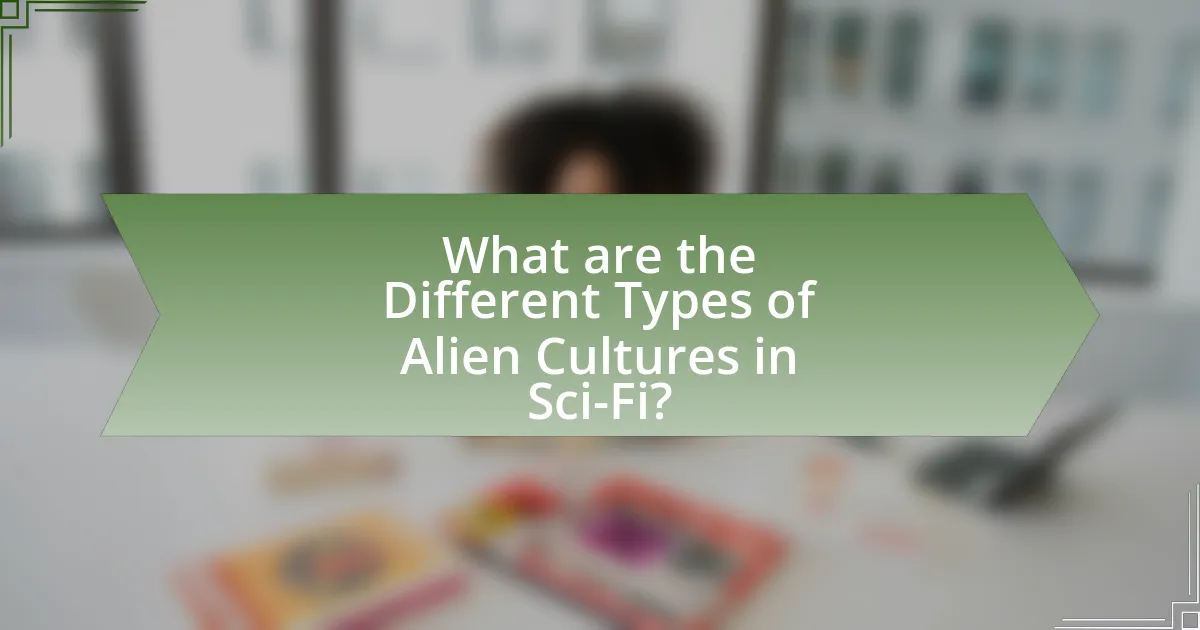
What are the Different Types of Alien Cultures in Sci-Fi?
Different types of alien cultures in sci-fi include militaristic, collectivist, individualistic, technologically advanced, and organic societies. Militaristic cultures often prioritize warfare and conquest, as seen in works like “Starship Troopers” by Robert A. Heinlein, where the society is heavily focused on military service. Collectivist cultures emphasize group identity and cooperation, exemplified by the Borg in “Star Trek,” who assimilate other species into their collective. Individualistic cultures, such as those depicted in “The Dispossessed” by Ursula K. Le Guin, highlight personal freedom and autonomy. Technologically advanced societies, like the Asari in “Mass Effect,” showcase sophisticated technology and its impact on culture. Organic societies, represented by the Na’vi in “Avatar,” emphasize harmony with nature and spiritual connections. Each type reflects diverse philosophical and ethical considerations within the genre.
How do alien cultures vary across different sci-fi subgenres?
Alien cultures vary significantly across different sci-fi subgenres, reflecting the thematic and narrative priorities of each category. In hard science fiction, alien cultures often emphasize scientific realism and technological advancement, showcasing societies that are deeply influenced by their environments and scientific principles, as seen in works like Arthur C. Clarke’s “Rendezvous with Rama.” In contrast, space opera subgenres tend to portray alien cultures with grandiose and often fantastical elements, focusing on epic conflicts and diverse species, exemplified by the “Star Wars” franchise, which features a wide array of alien species with distinct social structures and customs.
Moreover, speculative fiction often explores the sociopolitical implications of alien cultures, as illustrated in Octavia Butler’s “Lilith’s Brood,” where alien societies challenge human norms and provoke questions about identity and coexistence. In contrast, dystopian sci-fi may depict alien cultures as antagonistic or oppressive, reflecting human fears and societal critiques, as seen in “The War of the Worlds” by H.G. Wells. Thus, the portrayal of alien cultures is shaped by the subgenre’s focus, whether it be on scientific accuracy, epic narratives, sociopolitical commentary, or dystopian themes.
What are the characteristics of utopian alien societies?
Utopian alien societies are characterized by advanced technology, harmonious social structures, and sustainable living practices. These societies often exhibit a high level of cooperation among their members, leading to the absence of conflict and inequality. For instance, in Arthur C. Clarke’s “Childhood’s End,” the alien Overlords create a peaceful society on Earth by eliminating war and poverty, showcasing the potential for a utopian existence through external intervention. Additionally, such societies frequently emphasize environmental stewardship, as seen in Kim Stanley Robinson’s “Mars Trilogy,” where colonization efforts prioritize ecological balance. These characteristics illustrate the idealized vision of alien cultures in science fiction literature, reflecting humanity’s aspirations for a better future.
What defines dystopian alien cultures in literature?
Dystopian alien cultures in literature are defined by oppressive societal structures, often characterized by totalitarian governance, environmental degradation, and the dehumanization of individuals. These cultures typically reflect exaggerated versions of contemporary societal issues, such as inequality, surveillance, and loss of personal freedoms. For instance, in works like “The Dispossessed” by Ursula K. Le Guin, the contrasting societies of Anarres and Urras illustrate the consequences of political ideologies taken to extremes, showcasing how alien cultures can serve as a mirror to human societal flaws. Such narratives often employ alien settings to explore themes of resistance, identity, and the human condition, emphasizing the impact of oppressive systems on both individual and collective existence.
What role do alien languages play in cultural representation?
Alien languages serve as a crucial tool for cultural representation in science fiction literature by providing depth and authenticity to extraterrestrial societies. These constructed languages often reflect the values, beliefs, and social structures of the alien cultures they represent, enhancing world-building and reader immersion. For instance, the Klingon language in the “Star Trek” franchise not only adds realism but also embodies the warrior ethos of Klingon culture, showcasing their honor and combat traditions. This linguistic element allows readers to engage more fully with the narrative, as it conveys cultural nuances that would be lost in translation. Additionally, the use of alien languages can challenge human perspectives, prompting readers to consider the relativity of language and its impact on thought, as explored in works like “The Left Hand of Darkness” by Ursula K. Le Guin, where the language of the Gethenians influences their understanding of gender and identity.
How do constructed languages enhance world-building?
Constructed languages enhance world-building by providing depth and authenticity to fictional cultures. These languages create a unique linguistic identity that reflects the values, history, and social structures of the societies they belong to. For instance, J.R.R. Tolkien’s Elvish languages, such as Quenya and Sindarin, not only serve as communication tools but also enrich the lore of Middle-earth, illustrating the Elves’ ancient heritage and complex relationships. This linguistic detail fosters immersion for readers, making the fictional world more believable and engaging.
What challenges do authors face in creating believable alien languages?
Authors face significant challenges in creating believable alien languages, primarily due to the need for linguistic consistency and cultural context. Crafting a language that feels authentic requires a deep understanding of phonetics, grammar, and syntax, which can be complex when inventing entirely new linguistic systems. Additionally, authors must ensure that the language reflects the culture and worldview of the alien species, as language is deeply intertwined with social structures and values. For instance, the constructed languages in works like “Dune” by Frank Herbert or “The Languages of Pao” by Jack Vance illustrate how linguistic features can convey cultural nuances. These challenges necessitate a balance between creativity and linguistic realism to achieve credibility in the narrative.
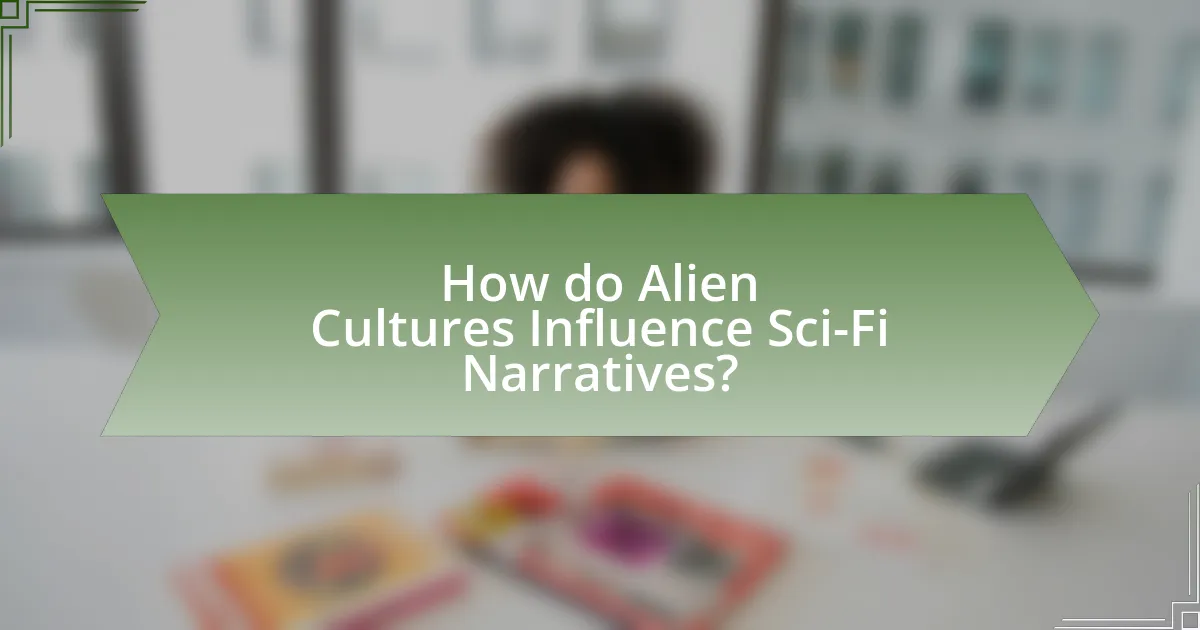
How do Alien Cultures Influence Sci-Fi Narratives?
Alien cultures significantly influence sci-fi narratives by providing diverse perspectives on humanity, ethics, and societal structures. These narratives often explore themes of coexistence, conflict, and the unknown, reflecting real-world issues through the lens of extraterrestrial interactions. For instance, in Arthur C. Clarke’s “Childhood’s End,” the arrival of an advanced alien race challenges human notions of progress and identity, illustrating how alien cultures can serve as a mirror to human society. Additionally, the portrayal of alien civilizations in works like Frank Herbert’s “Dune” emphasizes the complexity of cultural exchange and the consequences of imperialism, showcasing how these narratives can provoke critical thought about our own cultural practices and beliefs.
What impact do alien cultures have on plot development?
Alien cultures significantly impact plot development by introducing unique conflicts, themes, and character dynamics that drive narratives forward. These cultures often challenge human perspectives, creating scenarios that force characters to confront their beliefs and values. For instance, in Arthur C. Clarke’s “Childhood’s End,” the arrival of an advanced alien race alters human society, leading to profound existential questions and societal transformation. This interaction not only propels the plot but also deepens the exploration of human nature and morality, illustrating how alien cultures serve as catalysts for character growth and thematic depth in science fiction literature.
How do conflicts between human and alien cultures drive stories?
Conflicts between human and alien cultures drive stories by creating tension and exploring themes of identity, morality, and coexistence. These conflicts often serve as a catalyst for character development and plot progression, allowing authors to examine the complexities of communication and misunderstanding between vastly different societies. For instance, in works like “The War of the Worlds” by H.G. Wells, the invasion of Earth by Martians highlights human fears and prejudices, while also prompting reflections on imperialism and survival. Such narratives not only entertain but also provoke critical thought about cultural differences and the potential for empathy or conflict in real-world interactions.
What role does cultural exchange play in character development?
Cultural exchange significantly enhances character development by exposing individuals to diverse perspectives and values. This exposure fosters empathy, adaptability, and a deeper understanding of complex social dynamics. For instance, characters in sci-fi literature often undergo transformative journeys when they interact with alien cultures, leading to personal growth and moral dilemmas that challenge their preconceived notions. Such narratives illustrate how cultural exchange can serve as a catalyst for self-discovery and character evolution, as seen in works like “The Left Hand of Darkness” by Ursula K. Le Guin, where the protagonist learns to navigate and appreciate the intricacies of an alien society, ultimately reshaping their identity and worldview.
How can readers engage with alien cultures in sci-fi literature?
Readers can engage with alien cultures in sci-fi literature by immersing themselves in the diverse world-building and character development presented by authors. This engagement allows readers to explore complex societal structures, languages, and customs that differ from their own. For instance, works like “Dune” by Frank Herbert and “The Left Hand of Darkness” by Ursula K. Le Guin provide intricate portrayals of alien societies, encouraging readers to reflect on themes of identity, politics, and morality. These narratives often challenge readers to consider their own cultural assumptions and broaden their understanding of what constitutes civilization.
What are some recommended sci-fi works that explore alien cultures?
Recommended sci-fi works that explore alien cultures include “The Left Hand of Darkness” by Ursula K. Le Guin, which examines gender and society through the lens of an alien world. Another notable work is “Dune” by Frank Herbert, where the intricate cultures of the desert planet Arrakis are central to the narrative. “The Dispossessed,” also by Le Guin, contrasts two different societies, highlighting their cultural differences. “Childhood’s End” by Arthur C. Clarke presents an alien race that transforms human society, prompting deep cultural shifts. Lastly, “The Three-Body Problem” by Liu Cixin explores the complexities of first contact and the cultural implications of interacting with an alien civilization. These works are recognized for their profound insights into the nature of culture and society through the exploration of alien perspectives.
How can understanding alien cultures enhance the reading experience?
Understanding alien cultures enhances the reading experience by providing readers with diverse perspectives and enriching the narrative depth. When readers grasp the complexities of alien societies, including their customs, values, and conflicts, they can engage more fully with the story, leading to a deeper emotional connection with the characters and plot. For instance, in works like “Dune” by Frank Herbert, the intricate social structures of the Fremen culture allow readers to appreciate the themes of survival and adaptation in a harsh environment, thereby elevating the overall impact of the narrative. This understanding fosters critical thinking and empathy, as readers navigate the moral dilemmas faced by characters from vastly different backgrounds.
What are best practices for writing about alien cultures?
Best practices for writing about alien cultures include thorough research, cultural sensitivity, and imaginative world-building. Writers should study anthropological principles to create believable social structures, languages, and customs that reflect the diversity of human cultures. Incorporating elements such as unique belief systems, social hierarchies, and environmental influences can enhance authenticity. For instance, the portrayal of the Klingon culture in “Star Trek” demonstrates a well-developed alien society with its own language, traditions, and values, which resonates with audiences. Additionally, avoiding stereotypes and ensuring that alien cultures are not mere reflections of existing human cultures fosters a richer narrative. This approach not only respects the complexity of cultural identity but also engages readers by presenting them with innovative and thought-provoking perspectives.


